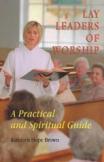A New Landscape in Ministry
Two faith questions guiding Kathleen Hope Brown’s small but timely and comprehensive book, Who is God? and Who am I? are worthy considerations for us all. Who am I as minister? is a question within those questions and a fundamental starting point for this text aimed at lay leaders of prayer in the church today.
Brown, a seasoned lay presider herself, is the regional director of the DeSales Spirituality Center in Washington, D.C. She brings this expertise to bear in a work intended for both those new to lay presiding and practiced ministers who may be searching for some nourishment and some fresh perspective. Since, as Brown notes, lay ministry and lay presiding are new territory, the book is particularly useful for the former group, especially because Brown refers to the tensions and challenges experienced by some lay presiders precisely due to the new look of this territory’s landscape. Because the book concludes with a model formation program for lay leaders of prayer, it is also a useful resource for those who form such ministers. It should be noted here that Brown suggests Lay Leaders of Worship as a companion to Sunday Celebrations in the Absence of a Priest (N.C.C.B., 1994) and A Ritual for Lay Persons (Liturgical Press, 1993).
A brief opening section introduces lay presiding in the larger context of lay ministry and makes the case for a holistic approach to the spiritual and personal formation of all lay ministers. Part One pursues the identity of the lay leader of prayer by first describing him or her as a minister of the word who responds to the call into relationship with the people of God and to service of them in community. The following chapters enlarge on this, giving attention to the sources of authority for such ministry, the spirituality of those who minister, the relational nature of ministry and the skills necessary. Included are lively quotations describing the mixed experiences of lay presiders (for example, a man who presides at a word and Communion service for an elderly community, and a woman who leads a Liturgy of the Word with children). The author’s own experiences as presider are particularly enlightening.
Part Two focuses on the formation of lay leaders of prayer and concludes with a modest but practical model of formation based on the vision gleaned in response to the question, who is the lay leader of prayer? Brown rightly begins with the necessary faith formation of all adults, not only those in formal church ministry. To this end, her model incorporates the six dimensions of adult faith formation proposed by the U.S. bishops in Our Hearts Were Burning Within Us, with particular emphasis on the scriptural component of the bishops’ plan so that adults might be both hearers and doers’ of the Word. Therefore, the sample schedule she offers for an evening formation meeting gives prayer and reflection on the Sunday Scriptures pride of place.
Altogether, this is a surprising book in that so much is covered, and so well, in just 111 pages (including two pages of bibliography). In an enlarged and perhaps revised format, this book could become a staple in the emerging field of lay leadership. Should that be the case, I suggest tighter editing, especially of repeated words (for example, vague, vagueness, vaguely defined). The often-repeated term spiritual leadership is new to me and to others whom I consulted.
These are small things, however, since the book’s theology is solid and the language sounds the right note for a work treating both the spirituality and the skills of those women and men who lead a community in worship in today’s church.
This article also appeared in print, under the headline “A New Landscape in Ministry,” in the May 10, 2004, issue.








